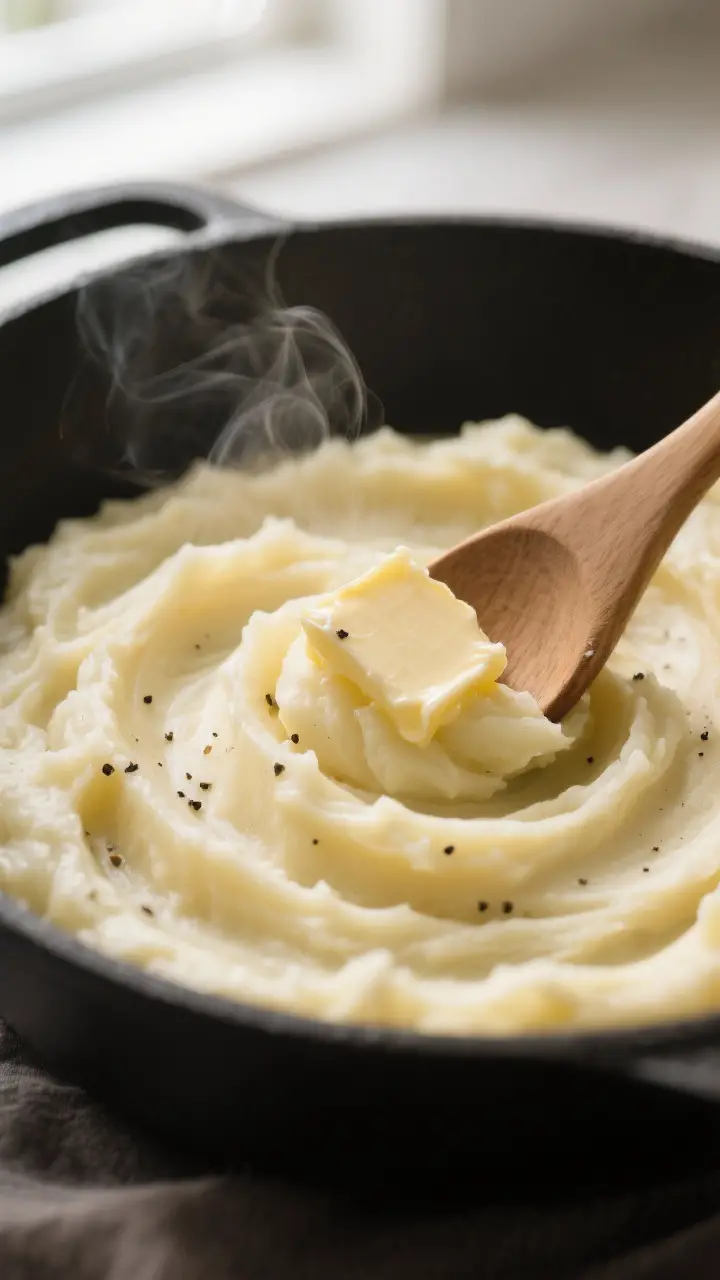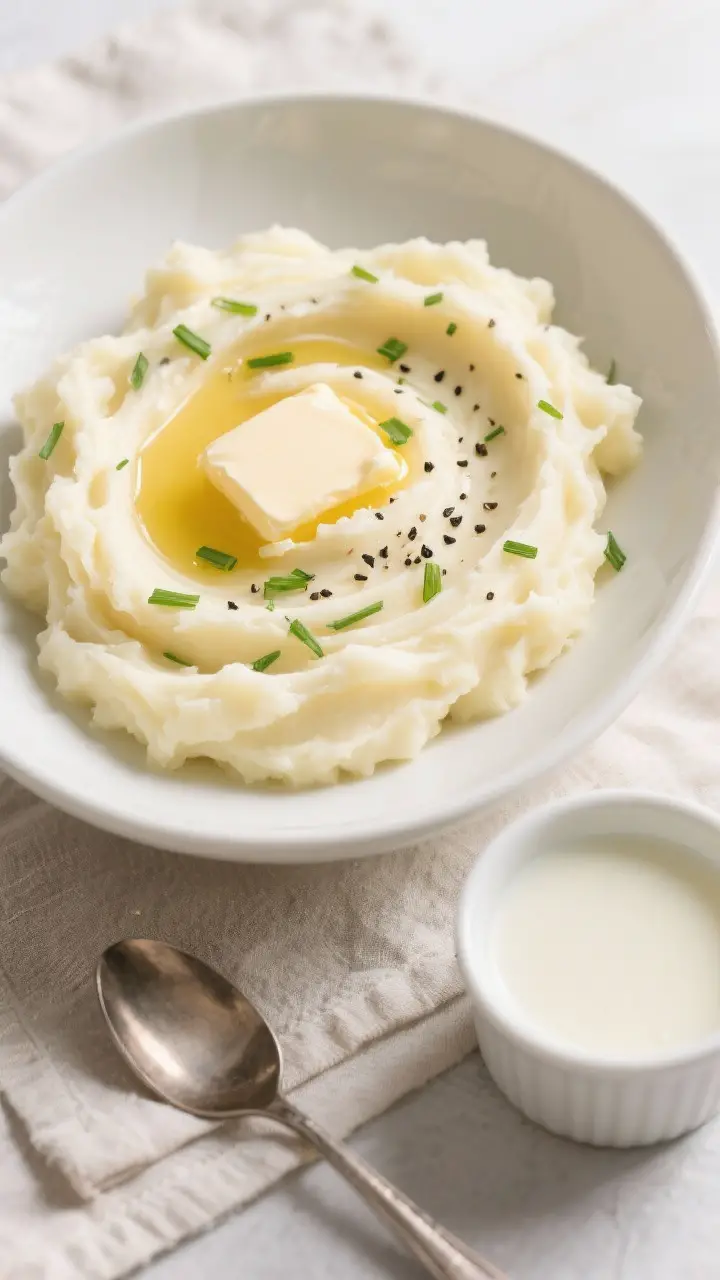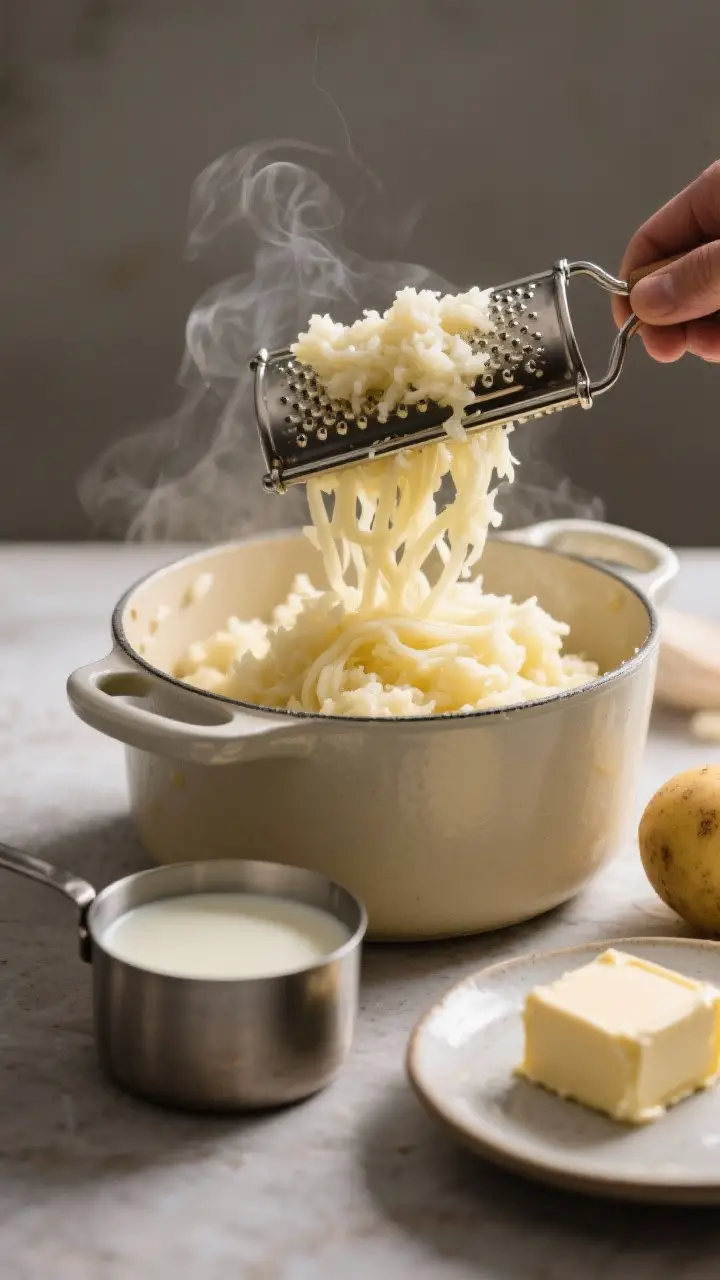You want silky, restaurant-level mashed potatoes without culinary school drama? Good. Because this is the playbook for cloud-like mash that makes people ask for seconds before they finish their first bite.
We’re not guessing here—this is dialed-in process, not vibes. We’ll talk potato type, precise fat, and the move that basically guarantees zero gluey disaster. You’ll never look at the box stuff again (sorry, not sorry).
What Makes This Recipe Awesome

This is the mash you imagine when you say “comfort food,” but with pro-level technique baked in.
We use starchy potatoes, simmered right, dried properly, and blended with hot dairy to lock in fluff and flavor. It’s rich without being heavy, and smooth without being pasty. Plus, these potatoes hold beautifully for holiday spreads and reheat like a dream.
If you want that luxurious, spoon-swooping texture, this is it.
What You’ll Need (Ingredients)
- 2.5 pounds Russet potatoes (or Yukon Golds for a slightly more buttery vibe; combo works too)
- 8 tablespoons (1 stick) unsalted butter, room temp or slightly softened
- 1 cup whole milk (or half-and-half for richer mash; heavy cream if you’re going all-in)
- 1 teaspoon kosher salt, plus more to taste
- 1/2 teaspoon freshly ground black pepper
- Optional flavor boosters: 1/4 cup sour cream or crème fraîche, 2–3 cloves roasted garlic, 2 tablespoons cream cheese, chives for garnish
- Optional finish: 2–3 tablespoons reserved potato cooking water for loosening
The Method – Instructions

- Peel and cut: Peel potatoes and cut into even chunks (about 1.5–2 inches). Uniform size = even cooking. No random potato boulders, please.
- Rinse off excess starch: Place cut potatoes in a colander and rinse under cold water until it runs clear.This helps prevent gummy mash.
- Start in cold, salted water: Add potatoes to a pot, cover with cold water by 1–2 inches, and add 1 tablespoon kosher salt. Cold start ensures the centers cook with the outsides.
- Simmer, don’t rage-boil: Bring to a gentle simmer over medium heat and cook until the potatoes are very tender, 15–20 minutes. A knife should slide in like butter.If it sticks, keep going.
- Drain and dry: Drain thoroughly, then return potatoes to the hot pot over low heat for 1–2 minutes, tossing, to steam off excess moisture. Dry potatoes absorb butter like a sponge—this is key.
- Warm the dairy: In a small saucepan, heat milk (and cream if using) until hot but not boiling. Warm dairy prevents the mash from seizing and turning gluey.Add pepper to the dairy now for even distribution.
- Mash smart: Use a potato ricer or food mill for the smoothest texture. If using a hand masher, mash gently. Do not use a blender or food processor unless you enjoy wallpaper paste.
- Butter first: Fold in the butter until fully melted and incorporated. Butter coats the starch granules first, keeping things silky.
- Add hot dairy gradually: Pour in about half the hot milk, stir, then add more until you hit your perfect consistency.You might not need it all. If you overshoot, a splash of potato water can rebalance texture.
- Season and upgrade: Taste, then add more salt and pepper as needed. For extra richness, fold in sour cream, roasted garlic, or cream cheese.Don’t overwork once the dairy is in—stir just until smooth.
- Hold like a pro: Keep warm in a covered heatproof bowl set over a pot with barely simmering water. Stir occasionally and add a splash of hot milk if thickening. Or keep covered in a warm oven (170–200°F).
- Serve with confidence: Finish with a pat of butter and chives if you’re feeling fancy.You earned this.
Storage Tips
- Fridge: Store in an airtight container up to 4 days. Press plastic wrap directly on the surface to prevent crusting.
- Reheat: Gently warm on the stove over low heat or in the microwave at 50–60% power, stirring and adding a splash of hot milk to loosen. Low and slow is your friend.
- Freezer: Yes, you can freeze.Cool completely, pack in freezer bags flat, and freeze up to 2 months. Thaw overnight in the fridge, then reheat with added cream or milk and a knob of butter.
- Make-ahead: Up to 2 days ahead is ideal. Reheat with hot milk in a saucepan, stirring occasionally, or hold warm in a slow cooker on Low with a bit of cream.

What’s Great About This
- Texture first: The butter-first, hot-dairy method makes ultra-smooth mash without the glue factor.
- Flexible richness: Choose milk for lighter, half-and-half for classic, or cream for “I regret nothing” energy.
- Foolproof flow: Rinsing, drying, and gentle mashing add up to repeatable, brag-worthy results.
- Scalable: This method works for 2 pounds or 12—great for holidays, meal prep, or Tuesday-night steak.
Pitfalls to Watch Out For
- Overmixing: Agitating potatoes releases starch and turns them gummy.Once smooth, stop. Your arm workout can wait.
- Cold dairy: Cold milk shocks the starch and tightens the mash. Warm it.It takes 2 minutes. Do it.
- Undercooking: If the centers aren’t tender, you’ll chase lumps forever. Cook until fully soft.
- Wrong tool: Food processors are potato assassins.Use a ricer, mill, or gentle masher—IMO the ricer is top-tier.
- Skipping the dry step: Waterlogged potatoes won’t absorb fat. That quick steam-off is a game changer.
Mix It Up
- Garlic-Parmesan: Stir in 2–3 cloves roasted garlic and 1/2 cup finely grated Parmesan. Finish with olive oil and cracked pepper.
- Buttermilk & Chive: Swap half the milk for buttermilk and fold in a handful of minced chives.Tangy, bright, and perfect with roasted chicken.
- Brown Butter Sage: Brown the butter until nutty, add a few crisped sage leaves, and fold in. Flavor level: ridiculous.
- Horseradish Smash: Add 1–2 tablespoons prepared horseradish and a dollop of sour cream. Excellent with beef.
- Truffle Flex: A drizzle of truffle oil or a teaspoon of truffle butter ramps up the luxe.Use lightly—this isn’t a perfume counter.
- Dairy-Free Dream: Use olive oil and warm unsweetened oat milk or almond milk. Add roasted garlic for richness.

Silky Restaurant-Style Mashed Potatoes
Equipment
- Potato Ricer
- Large Pot
- Saucepan
- Colander
Ingredients
Main Ingredients
- 2.5 pounds Russet or Yukon Gold potatoes peeled and cut into 1.5–2 inch chunks
- 8 tbsp unsalted butter room temperature
- 1 cup whole milk or half-and-half for richer texture
- 1 tsp kosher salt plus more to taste
- 1/2 tsp black pepper freshly ground
Optional Add-Ins
- 1/4 cup sour cream or crème fraîche for tangy richness
- 2-3 cloves roasted garlic optional, for flavor
- 2 tbsp cream cheese optional, for extra creaminess
- 2-3 tbsp reserved potato cooking water for loosening texture if needed
- chives chopped, for garnish
Instructions
- Peel and cut potatoes into 1.5–2 inch chunks for even cooking.
- Rinse cut potatoes under cold water until water runs clear to remove excess starch.
- Place potatoes in a large pot, cover with cold salted water by 1–2 inches, and add 1 tbsp kosher salt.
- Bring to a gentle simmer over medium heat and cook for 15–20 minutes, until tender and a knife slides in easily.
- Drain thoroughly, then return to the hot pot over low heat for 1–2 minutes to steam off excess moisture.
- In a small saucepan, heat milk until hot but not boiling. Add pepper for even distribution.
- Using a potato ricer or food mill, mash the hot potatoes back into the pot.
- Fold in butter first until fully melted and incorporated.
- Gradually pour in hot milk, stirring gently until desired consistency is reached. Avoid overmixing.
- Season with additional salt and pepper to taste. Fold in sour cream, roasted garlic, or cream cheese if desired.
- Hold warm by covering and placing over simmering water or in a 170°F oven until serving. Garnish with chives and butter before serving.
Notes
Nutrition
FAQ
Which potatoes are best for mashed potatoes?
Use Russets for the fluffiest, lightest result or Yukon Golds for a naturally buttery, slightly denser mash. A 50/50 blend gives you the best of both worlds.
Can I peel potatoes ahead of time?
Yes.
Peel and submerge in cold water with a pinch of salt up to 24 hours ahead, refrigerated. Change the water if it gets cloudy. This prevents browning and your future self will thank you.
How do I fix mashed potatoes that are too thick?
Warm a little more milk or cream and stir in a splash at a time until you reach your desired consistency.
Keep everything hot to avoid tightening the mash. FYI, it’s easier to add than subtract.
How do I fix gluey mashed potatoes?
Add more fat (butter or cream), fold in gently, and don’t overwork. If they’re really gone, spread in a baking dish, top with cheese, and turn them into a gratin.
No waste, only upgrades.
Is a potato ricer really worth it?
Absolutely. A ricer makes uniform, lump-free mash with minimal agitation. It’s the single tool that most reliably delivers that “restaurant smooth” texture at home.
Can I keep mashed potatoes warm for a crowd?
Yes.
Place in a slow cooker on Warm/Low with a splash of hot milk and a few pats of butter. Stir occasionally. Or set the bowl over a pot of simmering water for a simple bain-marie solution.
What’s the best way to add garlic?
Roasted garlic is sweet and mellow—ideal for creamy mash.
Mash 2–3 cloves into the butter before mixing. Raw garlic can be harsh; if using, simmer it in the milk to soften the bite.
In Conclusion
Great mashed potatoes aren’t luck—they’re technique. Start with the right spuds, control the heat, dry them well, and add butter first, hot dairy second.
From weeknight dinners to holiday showdowns, this mashed potatoes recipe delivers silky, scoopable comfort every time. Make it once, then make it “yours” with a signature twist. Your future gravy is already excited.











